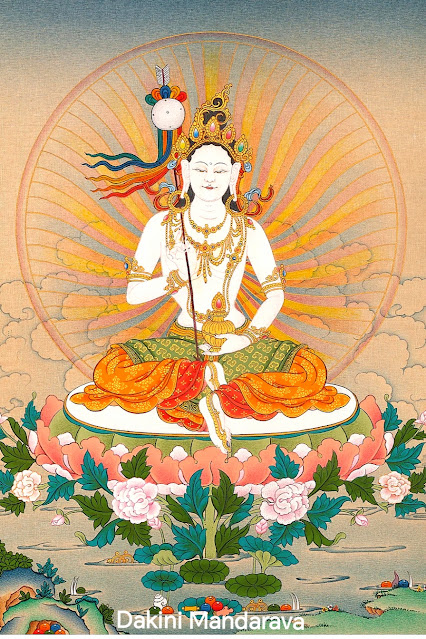The treatise Establishing Phenomena as Divine by Rongzom Pandita explicates the view of the generation stage. First of all, we should know that the essence of all things is the mandala of the Buddha. To reveal this mandala and actualize its theoretical view, we must rely on the practice of the generation stage.
The generation stage is the best skillful means to forcibly realise the truth that “all phenomena are the mandala of the Buddhas.”
Vajrayana holds that ordinary people have two kinds of attachment: the first is attachment to phenomena, that is, attachment to the inherent impurity of phenomena; the second is attachment to phenomena being not only impure but also real.
Encompassed in the second attachment are the Sutrayana notions of “attachment to self of person” and “attachment to self of phenomena.”
The first attachment can be eliminated with the practice of the generation stage. However, if we know only the method but not the view, confusion may arise during the practice—for instance, one might ask whether this practice is the same as the white skeleton visualization in Theravada, wherein an illusion is produced after the visualization.
Such confusion can cause great obstacles to our practice; hence, it is important to establish the view—to resolutely believe that all phenomena are the mandala of the Buddha. On the other hand, having the view but not actually applying it to practice, the knowledge remains always just theoretical.
Even if we can accept the view that all phenomena are the mandala of the Buddha, there is no way we can really experience how that is so. This is why we need the practice.
Most people believe the world as we know it will always stay the same as long as our sense organs do not change accidentally over the course of life. This is why the present world appears real, stable, but also impure to us.But in fact, this is not so. Let’s first put aside the argument whether the world exists or not. Even if it exists, the world cannot affect us in any way if our five sense organs do not interact with it; it is the same as if it does not exist.
For example, if our ear consciousness stops perceiving sound waves, then it does not matter, objectively speaking, whether sound waves exist or not. If they are perceived, sound in the impure state is a phenomenon of our mind; in the pure state, sound is transformed into the words of the Buddha.
After the generation stage practice is accomplished, this so-called unchanging world will be completely inverted. All impure phenomena will no longer exist; instead, the mandala of the buddhas will appear before the practitioner. The process of an ordinary person attaining buddhahood is in fact the process of transforming consciousness into wisdom.
Through practicing the generation stage, pure phenomena—that all is the mandala of the Buddhas—will manifest; this is also the state of the eighth-ground Bodhisattva after emerging from meditation.
*Footnote
For those who have received the empowerment of this Tantric practise, you are reminded not to intentionally or unintentionally disclose the mantra to the public or anyone who may not have the empowerment or permission to practise, and disclosing the mantra intentionally or unintentionally is a form of breaking your Tantric Samaya vows to the lineage masters and Dharma protectors.
Please consult your Guru or a qualified lineage master for Vajrayana practise! Should a devotee even want to start studying and contemplating the Vajrayana practise, then it is truly necessary to first have completed the preliminaries and to be certain that Bodhicitta has arisen and developed in one’s mind.
Vajrayana features countless skillful and powerful methods that, if practised in the proper way, can make the process of accumulation and purification incredibly swift and direct. It is absolutely necessary to have pure motivation and to know that Vajrayana practise is not carried out to increase one’s own ego, power, or self-interest.
Do you earnestly cherish our devoted work? Assuming this is the case, we are delighted that you are finding our blog useful and valuable. Would you consider making a donation for our Buddhist research and development?
We need your help to secure the future of scholarly interaction with Buddhism. Since our very first publication of Dharma works and activities in 2008, we have been effortlessly providing free distribution of Dharma posts and articles throughout the previous 14 years. We have exceptionally constrained support and do not receive subsidies or funding from people in general.
Please help us develop our Dharma activities that will not only benefit you but all Dharma readers on the planet. Please consider showing your support. Your generosity will certainly help us enhance our work and accomplish more for a better and brighter future.
Thank you for reading. May you find peace and great bliss. With your support, it helps to spread the Buddha’s precious teachings and turn the Dharma wheels in the world.
Aspiration For Bodhichitta
For those in whom the precious Bodhichitta has not arisen
May it arise and not decrease.
But increase further and further.
Dedication of Merit
By this merit, may we then obtain omniscience then.
Having defeated the enemies wrongdoings
May we liberate migratory from the ocean of existence.
With its stormy waves of birth, old age, sickness, and death.
*Note
I do not own or infringe any copyright on the picture(s).
Picture(s) courtesy and credit to the rightful distributors and/or studios
The picture(s) are intended for editorial use only.







































